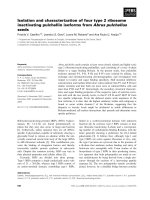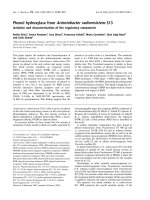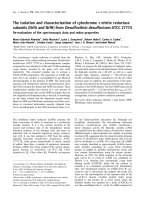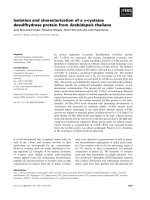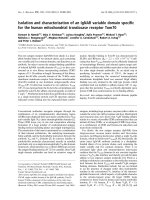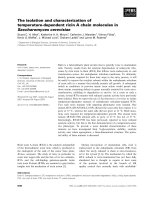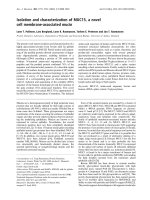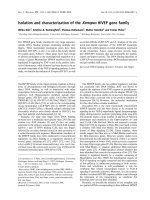Isolation and characterization of bacteria with antifungal activity against plant pathogens (khóa luận tốt nghiệp)
Bạn đang xem bản rút gọn của tài liệu. Xem và tải ngay bản đầy đủ của tài liệu tại đây (1.8 MB, 50 trang )
VIETNAM NATIONAL UNIVERSITY OF AGRICULTURE
FACULTY OF BIOTECHNOLOGY
------- -------
GRADUATION THESIS
TITLE: ISOLATION AND CHARACTERIZATION OF
BACTERIA WITH ANTIFUNGAL ACTIVITY
AGAINST PLANT PATHOGENS
Hanoi, December 2022
VIETNAM NATIONAL UNIVERSITY OF AGRICULTURE
FACULTY OF BIOTECHNOLOGY
GRADUATION THESIS
TOPIC: “ISOLATION AND CHARACTERIZATION OF
BACTERIA WITH ANTIFUNGAL ACTIVITY
AGAINST PLANT PATHOGENS”
Student name
: Nguyen Thi Hong Nhung
Student code
: 637162
Class
: K63CNSHE
Supervisor
: Dr. Dang Thi Thanh Tam
Faculty
: Biotechnology
Execution time
: 07/2022 – 12/2022
Hanoi – 10/11/2022
DECLARATION OF AUTHORSHIP
I hereby declare that this is my research work. The data, results and
reports mentioned herein are honest and have not been used to be published in
previous theses, dissertations, and scientific research works.
I hereby certify that the citation information used in the thesis is clearly
stated in the source, ensuring that the citation is correct as prescribed.
I take full responsibility for this promise!
Hanoi, November 2022
Student
Nguyen Thi Hong Nhung
i
ACKNOWLEDGMENT
During the process of completing this report, in addition to my efforts, I
received a lot of dedicated help from teachers, family, and friends. First of all, I
would like to express my sincere thanks to Dr. Dang Thi Thanh Tam - Lecturer
in the Department of Botany, Faculty of Biotechnology, Vietnam National
University of Agriculture - is the person who directly guided and imparted a lot
of valuable knowledge during the completion of the graduation thesis. , creating
all conditions for facilities and equipment to help me complete the assigned
topic.
At the same time, I would also like to express my deep gratitude to the
teachers at the Faculty of Biotechnology, the Vietnam National University of
Agriculture for their enthusiastic help and knowledge transfer during my time
studying at the school.
Finally, I would like to thank my family and friends who wholeheartedly
supported and encouraged me in the process of studying and completing this
report.
Hanoi, November 2022
Student
Nguyen Thi Hong Nhung
ii
ABSTRACT
This study aim to screen the potential bacterial isolates with antifungal
activity against plant pathogens from 86 isolates. From six different soil samples
in Northern regions (Ha Tay, Tuyen Quang, Quang Ninh, Hung Yen, Tue Vien,
Thai Binh) screened 86 bacteria isolates with antifungal activity on screening
plates. From 86 bacteria isolates were evaluated the antifungal activity of the
Fusarium oxysporum. Continue, selected twenty isolates displaying strong
antagonism against Fusarium oxysporum. Twenty potential isolates were
evaluated with antagonistic activity against Fusarium oxysporum after 3,5,7
days. In addition, evaluated the antifungal activity of twenty isolates against
other fungi such as Fusarium solani and Alternaria alternata after 3,5,7 days.
Since then, the selected 20 isolates were determined morphological, molecular,
physiological and biochemical characteristics (Gram staining, Catalase test, IAA
and morphology). Finally, some isolates showed strong antifungal activity
against plant pathogens: HT4(52%), HT2(58%), QN3(53%), TV2.5(60%),
TV2.11(54%), TV2.12(56%) and IAA production.
iii
CONTENT
DECLARATION OF AUTHORSHIP ................................................................... i
ACKNOWLEDGMENT ....................................................................................... ii
ABSTRACT ......................................................................................................... iii
CONTENT ........................................................................................................... iv
LIST OF TABLES ............................................................................................... vi
LIST OF FIGURES ............................................................................................. vii
PART 1: INTRODUCTION............................................................................... 1
1.1. Introduction .................................................................................................... 1
1.2. Aim and requirements .................................................................................... 2
1.2.1. Aim .............................................................................................................. 2
1.2.2. Requirements............................................................................................... 3
PART 2: LITERATURE REVIEW .................................................................. 4
2.1. Bacteria with antifungal activity against plant pathogens ............................. 4
2.1.1 Bacillus sp. ................................................................................................... 4
2.2. Fungal pathogens............................................................................................ 9
2.2.1. Fusarium oxysporum ................................................................................... 9
2.2.2. Fusarium solani......................................................................................... 10
2.2.3. Alternaria alternata .................................................................................. 11
2.3. Pathogenicity of Fusarium oxysporum ........................................................ 11
2.4. Control of Fusarium diseases....................................................................... 12
2.5. Studies of bacteria with antifungal activity against plant pathogens ........... 14
PART 3: MATERIALS AND METHODS ..................................................... 16
3.1 Materials ....................................................................................................... 16
3.1.1. The culture medium was used as follows ................................................. 16
3.1.2 Fungal pathogens........................................................................................ 16
3.1.3 Soil samples................................................................................................ 18
iv
3.1.4 Tools, chemicals ......................................................................................... 19
3.2. Methods ........................................................................................................ 19
3.2.1. Dilution Plate Method ............................................................................... 19
3.2.2. Gram Staining ........................................................................................... 20
3.2.3. Catalase test ............................................................................................... 21
3.2.4. Determination of indole -3-acetic acid (IAA) synthesis capability .......... 22
3.2.5. Screening of potential bacteria isolates with antagonistic activity against
fungal pathogens. ................................................................................................ 24
PART 4. RESULTS AND DISCUSSION ...................................................... 25
4.1 Results ........................................................................................................... 25
4.1.1 Experiment 1: Isolating and screening bacteria isolates with antifungal
activity ................................................................................................................. 25
4.1.2. Experiment 2: Screening of potential bacteria isolates with antagonistic
activity against fungal pathogens. ....................................................................... 26
4.1.3. Experiment 3: Evaluation of 20 potential isolates with antifungal activity
against fungal pathogens ..................................................................................... 27
4.1.4. Experiment 4: Characterization of the potential bacterial strains ............. 34
4.2.Discussion ..................................................................................................... 37
PART 5. CONCLUSION AND PROPOSAL ................................................. 38
5.1. Conclusion .................................................................................................... 38
5.2. Recommendations ........................................................................................ 38
REFERENCES .................................................................................................... 39
v
LIST OF TABLES
Table 4.1: Summarization of potential bacteria isolates with antifungal ........... 25
Table 4.2: Effects of bacteria strains on the mycelial growth inhibition to
Fusarium oxysporum (3-7 days). ........................................................................ 28
Table 4.3: Effects of bacteria strains on the mycelial growth inhibition to
Fusarium solani (3-7 days) ................................................................................. 30
Table 4.4: Effects of bacteria strains on the mycelial growth inhibition to
Alternaria alternata (3-7 days) ........................................................................... 32
Table 4.5: Characteristic of the potential bacterial strains. ................................. 34
Table 4.6: IAA production produced by potential isolates ................................. 35
vi
LIST OF FIGURES
Figure 2.1: Some probiotics are applied from bacillus strains with antifungal .. 14
Figure 3.1: Fusarium oxysporum ........................................................................ 17
Figure 3.2: Fusarium solani ................................................................................ 17
Figure 3.3 Alternaria alternata ........................................................................... 18
Figure 3.4: 6 soil samples .................................................................................... 18
Figure 3.5: Soil sample dilution and inoculation ................................................ 20
Figure 3.6: Gram staining steps .......................................................................... 21
Figure 3.7: Catalase test ...................................................................................... 21
Figure 3.8: Standard curve .................................................................................. 23
Figure 3.9: Experimental design images ............................................................. 24
Figure 4.1: The number of bacteria selected isolates from 6 soil samples ......... 26
Figure 4.2: Experimental design images ............................................................. 26
Figure 4.3: Antagonistic activity of screening isolates against
Fusarium
oxysporum ........................................................................................................... 27
Figure 4.4: Ten isolates showed strongest antifungal activity against Fusarium
oxysporum ........................................................................................................... 29
Figure 4.5: Ten isolates showed strongest antifungal activity against Fusarium
solani ................................................................................................................... 31
Figure 4.6: Ten isolates showed strongest antifungal activity against Alternaria
alternata .............................................................................................................. 33
Figure 4.7: Catalase test of 20 potential bacterial strains ................................... 36
Figure 4.8: Colonial morphology of 20 potential isolates with antifungal activity
against fungal pathogens ..................................................................................... 36
vii
PART 1: INTRODUCTION
1.1. Introduction
Plants often suffer from diseases caused by fungi, bacteria, protists,
nematodes, and viruses. Plant pathogens are of scientist interest for some
reasons, ranging from concerns about fragile ecosystems to the desire to protect
the food supply. Plant pathogens that cause plant diseases reduce a grower’s
ability to produce crops and can infect almost all types of plants. Plant
pathogens cause disease in plants and cause losses in food and other necessary
items. The losses may be light or very severe, sometimes destroying all the
plants and causing hunger, starvation and famines. Some common plant diseases
such as Black spots, other leaf spots, powdery mildew, downy mildew, blight,
etc. In Vietnam, plant diseases caused by fungi are very common and seriously
affect agriculture and the economy. One of them is a plant disease caused by
Fusarium oxysporum, Fusarium solani, and Alternaria alternata.
Fusarium oxysporum is also a ubiquitous fungus widely distributed in the
environment. Fusarium oxysporum diseases are significant hindrances to food
plant production and are very difficult to control, especially soilborne diseases
caused by Fusarium oxysporum. Soilborne plant diseases are those caused by
the infection of pathogens in soil via the roots. Fusarium oxysporum is a
representative of soilborne pathogens. It inhabits the soil for a long time in the
form of chlamydospores. It penetrates the roots, extends in the tissues, colonizes
and metastasizes in xylem vessels, and causes systemic yellowing, wilting, and
death in plants (Arie, 2019).
In Vietnam, Fusarium oxysporum causes diseases in bananas, cabbage,
tomatoes, peppers etc. Fusarium oxysporum has strong growth at soil
temperatures above 24°C and can live indefinitely in soil without access to
living host plants. Infected plants are usually stunted; their leaves turn pale
green to golden yellow and later wilt, wither, die, and drop off progressively
1
upward from the stem base. Dark streaks occur in the xylem vascular tissue of
the roots and lower stem, and the roots may decay. Infected seedlings will wilt
and die. Currently, farmers rely heavily on pesticides, but toxicity hazards to
farm workers, consumers, and non-target organisms as well as environmental
contamination cause great concern. Using beneficial and antagonistic
microorganisms for biological control offers a potential, environmentally
friendly and effective approach to control Fusarium oxysporum. So, the
objective of this study was to evaluate bacteria strains isolated with antagonistic
activity against Fusarium oxysporum. These isolates inhibited Fusarium
oxysporum mycelial growth in vitro and reduced Fusarium oxysporum disease
severity in plants grown in Fusarium oxysporum infested. The potential use of
microorganisms in the treatment of plant fungal diseases is based on the
antagonistic nature of microbes towards fungal pathogens. In addition, some
bacteria have the ability to promote plant growth, such as the synthesis of plant
auxin indole-3-acetic acid (IAA) and its analogs. The results of experimental
studies of microbial antagonists against plant fungal pathogens are promising.
In this study, we would like to explore the possibility of using natively
isolated bacteria strains which were collected from 6 different soil samples in
Northern regions for Fusarium oxysporum antagonism. Then, we selected 20
isolates displaying strong antagonism against Fusarium oxysporum. In addition,
these isolates also have the ability to stimulate plant growth. With these two
characteristics, it will help plants easily resist plant pathogens. This study is
helpful to initially assess the biocontrol potential of these antagonistic strains.
1.2. Aim and requirements
1.2.1. Aim
Isolating and selecting potential bacterial strains with antagonistic activity
against fungal pathogens.
2
1.2.2. Requirements
Isolation of potential bacterial strains can suppress fungal pathogens from
six soil samples.
Collected bacterial strains with antifungal activity against fungal
pathogens.
Screening of potential bacterial isolates with antagonistic activity against
fungal pathogens with Fusarium oxysporum, Fusarium solani, Alternaria
alternata.
Selecting potential bacterial strains have
antifungal activity against
fungal pathogens (Fusarium oxysporum, Fusarium solani, Alternaria alternata).
Characteristic of the potential bacterial strains.
3
PART 2: LITERATURE REVIEW
2.1. Bacteria with antifungal activity against plant pathogens
Biological control is an environmentally-friendly alternative to chemical
pesticides and it is an attractive method of protecting plants from pathogens
because the wide usage of chemicals has a negative impact on the environment
and human health. Soil-borne bacteria that are antagonistic to plant pathogens
could make a substantial contribution to prevention of plant diseases, and
therefore represent an alternative to the use of chemical pesticides in agriculture
Many biocontrol agents were isolated by screening a large number of soil or
plant-associated microorganisms for antagonism against phytopathogens in vitro
or plants. Some bacterial species with antagonistic activity were isolated from
the rhizosphere of different plants. Among those, bacilli and pseudomonads are
the most common isolates. In the world, various species of the Bacillus genus
can stimulate plant growth. Plant growth can be promoted by bacteria through
several mechanisms, including improved nutrition, systemic resistance, toxicity
against pests, and antagonism against pathogens. Many Bacillus isolates were
shown to have antifungal activity against phytopathogenic fungi which make
them good biocontrol candidates (Mardanova et al., 2017).
2.1.1 Bacillus sp.
The antagonistic activity of Bacillus is associated with the synthesis of
various antimicrobial peptides, secreted enzymes, proteins and volatile organic
compounds (VOCs). Many Bacillus isolates were shown to have antifungal
activity against phytopathogenic fungi that make them good biocontrol
candidates. Bacillus sp. form endospores and can tolerate extreme conditions
such as pH, temperature, and osmotic pressure; they therefore offer several
advantages over other types of organisms. Bacillus sp. was found to colonize the
root surface, increase plant growth, and cause lysis of fungal mycelia. They
4
areregarded as safe biological agents and their potential is considered high
(Islam et al., 2012). Bacillus is a microbial strain 0.5 µm to 20 µm in size, rodshaped, gram-positive, spore-forming, aerobic or facultative anaerobic. Bacillus
frequently occur in chains. There are many strains of Bacillus used in
agriculture, including: Bacillus thuringiensis, Bacillus subtilis, Bacillus
amyloliquefaciens, Bacillus licheniformis (Islam et al. , 2012).
2.1.1.1 Bacillus thuringiensis
Bacillus thuringiensis is an aerobic, soil-dwelling bacterium, produce
Gram-positive spores and produce proteins with powerful insecticidal
properties. Bacillus thuringiensis is considered to be one of the most successful
biopesticides ever used against insect pests of crops. The activity of Bacillus
thuringiensis subsp. thuringiensis delta-endotoxin against pathogenic fungi
related to Phytophthora and Fusarium was investigated. A possible mechanism
of delta-endotoxin's antifungal activity involves the uncoupling of oxidative
phosphorylation and respiration. In the fungal cultures, the toxin increased
respiratory activity. This effect was comparable with processes that occurred in
insect cells after contact with entomopathogenic bacteria. The antifungal activity
of delta-endotoxin against phytopathogenic fungi was dependent on the
concentration and time of contact with fungal cells. The protective effects of the
endotoxin against Fusarium oxysporum f. sp. Lycopersici as a causative agent of
wilt and late blight disease was estimated throughout the storage of tomatoes.
Additionally, the delta-endotoxin has a cytostatic effect on several economically
important phytopathogenic fungi related to Fusarium, Bipolaris, Phytophthora,
Alternaria, and Rhizoctonia. A single cell structure of eukaryotic organisms
demonstrated the universal mechanism of the Bacillus thuringiensis deltaendotoxin action to both insect and fungal cells (Tran et al., 2001). However, the
mechanism of the antifungal action of delta-endotoxins remains scantly
explored. Subsequent study of the relationship of delta-endotoxins with
5
phytopathogenic fungi was of practical importance from the perspective of the
development of novel microbial pesticides for control of plant diseases. This
work was to study the influence of the delta-endotoxin Bacillus thuringiensis on
phytopathogenic fungi, as well as to assess its efficacy as a potential microbial
fungicide (Kamenek et al., 2012).
2.1.1.2. Bacillus subtilis
Bacillus subtilis is a gram-positive, rod-shaped bacterium that forms
heat-resistant spores. It is commonly found in the soil, straw and grass. It is
nonpathogenic. Bacillus subtilis has the ability to improve soil and stimulate
plant growth by mechanisms: decomposition of organic matter, nitrogen
fixation, production of plant growth hormones. In addition, it also treats
agricultural by-products, produces microbial fertilizers, biocontrol against
pathogenic fungi (Hashem et al., 2019).
Bacillus subtilis produces peptidolipid compounds of the iturin group
have antifungal properties. Bacillus subtilis has been used successfully for the
biological control of fungal plant pathogens and peach storage rot. The iturins
include a number of antifungal compounds, such as bacillomycin and
mycosubtilin. Some members of the iturin group inhibit the germination of
spores from a variety of fungi (Klich et al., 1991). A strain of Bacillus
subtilis which produces an antibiotic metabolite was also found to produce a
volatile compound which was antifungal to Rhizoctonia solani and Pythium
ultimum. Bacillus subtilis ZD01, an effective antifungal strain, was isolated and
identified from potato rhizosphere, and the antifungal effects of VOCs produced
by it on Alternaria solani
were investigated by both in vivo and in
vitro experiments. Bacillus subtilis have great potential to be used as a
biologically synthesized fungicide in the agricultural field. Strain ZD01
produces volatile organic compounds that can reduce colony size and mycelial
penetration and can significantly alter the morphology of Alternaria solani.
6
Scanning electron microscope (SEM) observation showed that VOCs released
by ZD01 could cause more flaccid and gapped hyphae of Alternaria solani.
Also, VOCs produced by ZD01 can inhibit the conidia germination and reduce
the lesion areas and number of Alternaria solani in vivo significantly (Zhang et
al., 2020).
2.1.1.3. Bacillus amyloliquefaciens
Bacillus amyloliquefaciens is a gram-positive, nonpathogenic, endosporeforming, member of a group of free-living soil bacteria they have the ability
plant growth promotion, production of antifungal and antibacterial metabolites.
They are widely used in agricultural production such as:
+ Increased resistance in adverse environments: cold, drought, especially
saline sodic soil.
+ Stimulating plant resistance, increasing resistance to pathogens and
stimulating plant growth (Chowdhury et al., 2015).
The Bacillus amyloliquefaciens gains lots of research interest and is
widely applied in agriculture, pharmaceuticals, food, and environmental
industries. It has been found that Bacillus amyloliquefaciens promotes plant
growth via a number of mechanisms, acts as a biocontrol agent against a variety
of plant diseases caused by soil-borne microorganisms, is widely used as a
biofertilizer and biopesticide, inhibits pathogen growth by competing with
essential nutrients, produces antibiotics and induces systemic acquired resistance
(Liu
et
al.,
2021).
For
instance,
VOCs
produced
by Bacillus
amyloliquefaciens NJN-6 could hinder growth and spore germination of the
pathogenic Fusarium oxysporum f. sp. cubense causing fusarium wilt on banana
(Yuan et al., 2012)
2.1.14. Bacillus lichenformis
Bacillus licheniformis is a rod-shaped, gram positive motile bacterium,
Bacillus lichenformis is a facultative anaerobe (Akhtar et al., 2020). Colonies
7
are both round and irregular in shape, with irregular (undulate, fimbriate)
margins. The surface of B. licheniformis colonies are often rough and wrinkled,
with "licheniform", or hair-like growths. Color ranges from opaque to white.
Bacillus licheniformis has a very good effect on preventing plant diseases. It can
be used to improve the soil, improve the microbial ecological environment of
the soil and increase fertilizer use efficiency.
Biological control using antagonists provides an alternative to the use of
pesticides for controlling plant diseases. Bacillus species are known to produce
various antibiotics and antifungal compounds that inhibit phytopathogenic fungi.
Bacillus licheniformis has been reported to produce different antifungal
molecules such as fungimycin M4, which inhibits the growth of fungi such as
Sporothrix schenckii, and Microsporum canis. Bacterial antagonist exhibiting
highest antifungal activity against the rice blast fungus Magnaporthe grisea was
isolated from soil and identified as Bacillus licheniformis BC98. Besides
Magnaporthe grisea, the isolate also inhibited the growth of other
phytopathogens such as Curvularia lunata and Rhizoctonia bataticola
(Tendulkar et al., 2007).
2.1.1.5. The applicability of some strains of Bacillus sp. have antagonistic
activity against pathogenic fungi and stimulate plant growth.
Many chemical fungicides are available to control the important crop
diseases, caused by Fusarium oxysporum, Rhizoctonia solani, Botrytis
cinereapers, Gibberella zeae, Dothiorella gregaria, Colletotrichum gossypii and
others. However, chemical pesticides are not ideal for long term application due
to the concerns associated with exposure risks, health and environmental
hazards, residual persistence and tolerance of pathogenic fungi. In recent years,
biopesticides have been used to control pests in an environmentally friendly
way. Bacillus spp. was discovered as a soil bacterium, which has been used as a
biopesticide in agriculture. Recently, biocontrol agents viz., Pseudomonas sp.
8
and Bacillus sp. have been used for induced systematic resistance against plant
diseases. A mixture of Bacillus amyloliquefaciens strain IN937a and Bacillus
pumilus strain IN937b were found to consistently provide a broad spectrum of
protection against both soil and air-borne pathogens, including cucumber mosaic
virus, Colletotrichum gloeosporioides, Ralstonia solanacearum, Rhizoctonia
solani, and Sclerotium rolfsii (Wang et al., 2009).
2.2. Fungal pathogens
The quality, quantity and profitability of plant production are impacted by
plant fungal pathogens. These phytopathogens are persistent in avoiding plant
defences causing diseases and quality losses around the world that amount to
billions of US dollars annually. To control the scourge of plant fungal diseases,
farmers have used fungicides to manage the damage of plant pathogenic fungi.
Researchers and cultivators have searched for alternatives to these chemicals
due to drawbacks such as resistance development and environmental toxicity. In
this study, to evaluation of 20 isolates with antifungal activity we used 3 fungi:
Fusarium oxysporum, Fusarium solani and Alternaria alternata.
2.2.1. Fusarium oxysporum
Kingdom
Fungi
Division
Ascomycota
Class
Ascomycetes
Order
Hypocreales
Family
Nectriaceae
Genus
Fusarium
Species
F. oxysporum
On potato dextrose agar, Fusarium oxysporum produces white, pale blue,
purple, or light orange mycelial colonies. Microconidia are unicellular,
colorless, and oval, and are formed on short conidiophores branching from the
9
mycelium as unicellular, colorless, and oval microconidia on arched
macroconidia. Chlamydospores are durable and can survive in the soil for
several decades after being produced by thickened cell walls in mycelial cells
and macroconidia cells (Arie, 2019).
On PDA Fusarium oxysporum produces:
• A wide range of pigments produced by fungal colonies growing on agar,
from colorless to purple to amaranth
• Mycelium is white to purple (Burgess et al., 2009)
Fusarium oxysporum is a cosmopolitan species that are widely spread in
all types of soil worldwide. Fusarium oxysporum to causing severe vascular
wilts and root rot diseases in various crops.
• Fusarium oxysporum cultureted in PDA and water agar medium at 30°
for 7-10 days.
2.2.2. Fusarium solani
Kingdom
Fungi
Division
Ascomycota
Class
Ascomycetes
Order
Hypocreales
Family
Nectriaceae
Genus
Fusarium
Species
F. sonali
Fusarium solani produces colonies that are white and cottony and has
aerial hyphae that give rise to conidiophores laterally. Fusarium solani colonies
are low-floccose, loose, slimy, and sporadic. On the PDA medium, it develops
quickly. Fusarium solani causes disease in economically important crops such
as avocados, citrus, orchids, passion fruit, peas, peppers, potato, and squash.
Fusarium solani rots the roots of its host plant.
10
2.2.3. Alternaria alternata
Kingdom
Fungi
Division
Ascomycota
Class
Dothideomycetes
Order
Phleosporales
Family
Pleosporaceae
Genus
Alternaria
Species
A. alternata
Alternaria alternata is a fungus which has been recorded causing leaf spot
and other diseases on over 380 host species of plant. It is an opportunistic
pathogen on numerous hosts causing leaf spots, rots and blights on many plant
parts causing losses in yield print agricultural crops. Alternaria alternata causes
black spots in many fruits and vegetables around the world. In order to survive,
Alternaria alternata needs a moist warm environment. It is often found in areas
with humid climates, or where there has been significant rainfall. The fungus
lives in seeds and seedlings, and is also spread by spores.
2.3. Pathogenicity of Fusarium oxysporum
Fusarium oxysporum strains are known to cause Fusarium wilt among
other diseases. Wilts pose a significant threat to agriculture, and Fusarium
oxysporum ranks among the 10 most damaging fungi in the world. Affected
crops can suffer serious yield losses because some strains of the disease can also
cause foot- and root-rot. There is the potential for devastating crop losses due to
Fusarium oxysporum pathogens that have evolved. (De Lamo & Takken, 2020).
Soilborne plant diseases are those caused by infection of pathogens in
soil via the roots. Fusarium oxysporum is representative of soilborne pathogens.
It inhabits the soil for a long time in the form of chlamydospores, penetrates the
roots, extends in the tissues, colonizes and metastasizes in xylem vessels and
11
causes systemic yellowing, wilting, and death in plants. The wilt-inducing
strains of Fusarium oxysporum are responsible for severe damage on many
economically important plant species.
Symptoms:
The symptoms caused by Fusarium oxysporum and its various formae
speciales are vascular wilt, yellows, corm rot, root rot, and damping-off. The
most important of these is vascular wilt. Of the vascular wilt-causing Fusaria,
Fusarium oxysporum is the most important species. Strains that are rather poorly
specialized may induce yellows, rot, and damping-off, rather than the more
severe vascular wilt.
As Fusarium wilt is the most important disease caused by Fusarium
oxysporum, the focus of this section will be on this symptom. The first sign of
Fusarium wilt is the slight drooping of the older leaves along with vein clearing
on the outer portion of the younger leaves. At the seedling stage, plants infected
by Fusarium oxysporum may wilt and die soon after symptoms appear. In older
plants, vein clearing and leaf epinasty are often followed by stunting, yellowing
of the lower leaves, formation of adventitious roots, wilting of leaves and young
stems, defoliation, marginal necrosis of remaining leaves, and finally death of
the entire plant. Browning of the (vascular tissue) is strong evidence of
Fusarium wilt. Further, on older plants, symptoms generally become more
apparent during the period between blossoming and fruit maturation (Andre K.
Gonsalves et al., 1993).
2.4. Control of Fusarium diseases
Current general status of soilborne Fusarium disease control
Once soilborne funeral pathogens spread in the field, their removal is very
difficult. Currently, to control the diseases caused by soilborne pathogens, soil
disinfection using fumigants, such as chloro pickin, hot water, or solarization, or
using resistant cultivars is popular. However, the efficacy obtained with these
12
treatments often is not as good as expected. In addition, there is a need to reduce
their usage because of adverse effects on the environment.
In order to solve these problems, other techniques for controlling
Fusarium are being developed. Here, studies on biological control and inducing
disease resistance in plants as alternatives to controlling fusarium diseases are
presented.
Preventive measures:
+ Choose disease-free bulbs. Seed bulbs need to be selected in the field
and need to be stored separately.
+ Harvest at the right time. When harvesting, it is necessary to collect
and separate the wild plants for use first.
+ Rotate crops thoroughly from 3-4 years on severely diseased fields
with other crops.
+ Don't water too wet.
+ Planting trees on high ground, easy to drain, free to drain.
+ Apply lime powder to raise soil pH on acidic soil.
+ Fertilize with decaying organic fertilizers
+ Use biological products Bacte Cinsan to spray to prevent diseases at the
beginning of the rainy season, kill pathogens or spray treatment when plants are
sick…
Chemical measures:
+ Use some of the following drugs to prevent: Ningnanmycin (Niclosat
2SL); Trichoderma viride (Biobus 1.00 WP); COPPER-B 75WP; Prevent root
nematodes (creating a "gateway" for fungal attack) by periodically watering
Trichoderma Bacillus & EM HLC probiotics that treat nematodes from seedling
stage to harvest stage to help prevent diseases. Root rot, green wilt, yellow wilt,
etc.
13
Figure 2.1: Some probiotics are applied from bacillus strains with antifungal
(Source: Vinong.net Vietnamnongnghiepsach.com.vn)
Currently, the main strategy for managing Fusarium infections has been
chemical fungicides. So, the utilization of biological control agents in disease
management programs has provided an effective, safe, and sustainable means to
control Fusarium-induced plant diseases. Beneficial strains of Bacillus rank high
for their potential but also because they are spore-forming bacteria, which makes
them easy to formulate and preserve as inoculants. Due to their ability to
produce a range of metabolites that promote plant growth and reduce pathogen
attack, either by suppressing fungal growth or by stimulating the plant's immune
system against pathogens. Finally, microbial consortiums may reduce plant
diseases, improve crop growth, and maintain environmental health by reducing
plant disease and improving crop production (Khan et al., 2017).
2.5. Studies of bacteria with antifungal activity against plant pathogens
The use of Bacillus sp. species to Fusarium wilt caused by Fusarium
oxysporum is a new direction of interest to many scientists. Several studies have
been done to demonstrate their benefits in biocontrol of Fusarium wilt.
The study 57 antagonistic bacterial strains were isolated from the
rhizospheres of healthy banana plants grown in a heavily wilt-diseased field; of
the 57 strains, six strains with the best survival abilities were chosen for further
study. Compared with the control and the other strains in the greenhouse
14
experiment, W19 strain was found to observably decrease the incidence of
Fusarium wilt and promote the growth of banana plants when combined with the
organic
fertilizer
(OF).
This
strain
was
identified
as
Bacillus
amyloliquefaciens based on its morphological, physiological, and biochemical
properties, as well as 16S rRNA analysis. Two kinds of antifungal lipopeptides
(iturin and bacillomycin D) produced by W19 strain were detected and
identified using HPLC–ESI-MS. Another lipopeptide, called surfactin, was also
produced by the thick biological film forming W19 strain. In addition to
lipopeptides, 18 volatile antifungal compounds with significant antagonistic
effect against Fusarium oxysporum were detected and identified using gas
chromatography–mass spectrometer (GC–MS). The work described herein not
only
highlights
how
the
bioorganic
fertilizer
with
Bacillus
amyloliquefaciens can be used to control Fusarium wilt of banana but also
examines some of the potential mechanisms involved in the biocontrol of
Fusarium wilt (Wang et al., 2012).
Combinatorial effect of endophytic and plant growth promoting
rhizobacteria against wilt disease of Capsicum annum L. caused by Fusarium
solani. Research shows that rhizobacterial strains (Pseudomonas fluorescens;
Pf1) against chilli wilt disease caused by Fusarium solani (Sundaramoorthy et
al., 2012).
15
PART 3: MATERIALS AND METHODS
3.1 Materials
3.1.1. The culture medium was used as follows
To isolate, screen, and evaluate bacteria that are resistant to fungal
diseases, we use some medium types: NA, PDA, SDA, and LB.
Medium PDA (Potato Dextrose Agar): Potato Dextrose Agar—39 g,
Water—1 L, pH = 7.
Medium NA (Nutrient agar): Peptone—5 g, Beef Extract—3 g, Sodium
Chloride—5 g, Agar—20 g, Water—1 L, pH = 7.
Medium LB (Luria Bertani): Tryptone—10 g, Yeast Extract—5 g,
Sodium Chloride—10 g, Water—1 L, Agar—15 g pH = 7.
Medium SDA (Sabouraud Dextrose Agar): Agar—20 g, Sabourand
Dextrose broth—30 g, Water—1 L
Medium water agar: Agar—20 g, Water—1 L
Medium LB + L-trytophan: Tryptone—10 g, Yeast Extract—5 g, Sodium
Chloride—10 g, Water—1 L, Agar—15 g, L-Trytophan (100mg/L) pH = 7.
3.1.2 Fungal pathogens
For the screening of bacteria resistant to plant fungal diseases, we used
three fungal pathogens: Fusarium oxysporum, Fusarium solani, Alternaria
alternata (all from the Faculty of Biotechnology, Vietnam National University
of Agriculture). The fungal pathogens were maintained on a potato dextrose agar
(PDA) medium at room temperature in the darkness.
Fusarium oxysporum: In the laboratory, we cultured on PDA medium at
30°C in the darkness.
16

